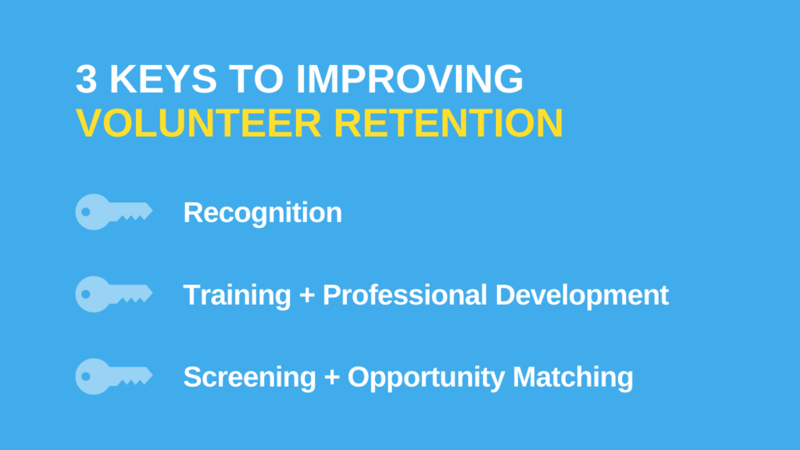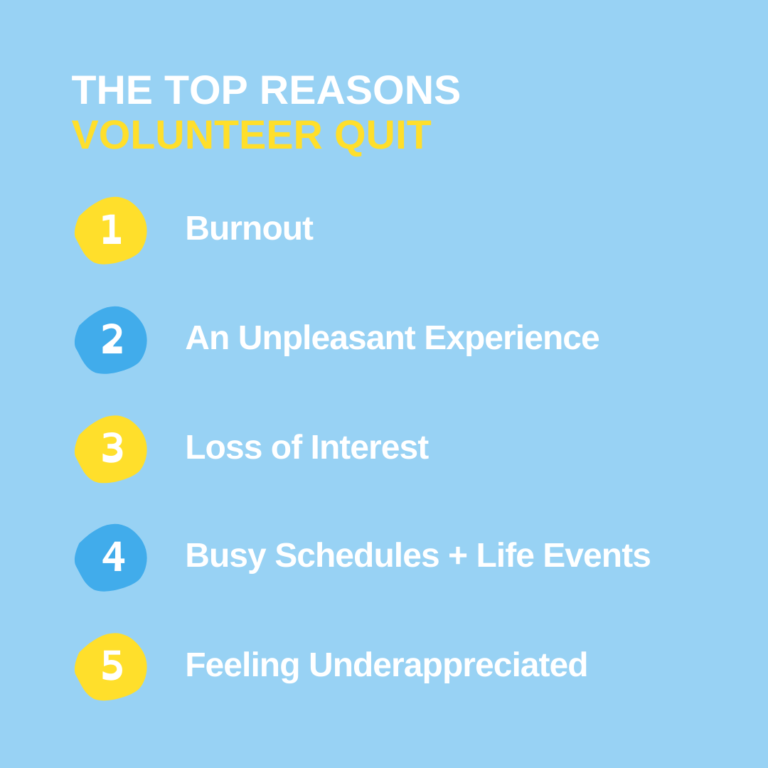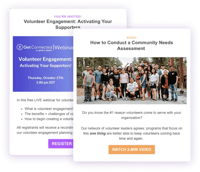Get the free Volunteer Lifecycle Planning Guide
You’ve mastered volunteer recruitment, and you’re already scheduling volunteers efficiently, but are you devoting enough attention to volunteer retention?
Volunteer retention is a crucial component of any volunteer management strategy. But many volunteer programs shy away from formalizing volunteer retention strategies simply because they’re not sure where to start or even what successful volunteer retention looks like.
The good news: volunteer retention doesn’t have to be rocket science. In fact, with some time, planning, and a time-saving volunteer management tool, you’re well on your way to boosting volunteer retention and, in turn, improving your program’s efficiency.
Article Contents:

Volunteer Retention: The Basics
Before we jump into volunteer retention best practices, let’s answer the questions volunteer leaders ask the most:
What is Volunteer Retention?
Volunteer retention is an organization’s ability to keep and engage active volunteers for a given period of time.
Think of volunteer retention as the opposing factor of volunteer turnover (how quickly a volunteer stops participating in volunteer activities after joining your organization). High turnover rates directly impact retention.
Download the free Volunteer Lifecycle Planning Guide!
But how long is a “given period of time” exactly? And what is considered “quick volunteer turnover?” Every volunteer program will have their own answer; your definition of volunteer turnover will depend on your organization’s goals and the types of volunteer opportunities you promote.
Alternatively, organizations can choose to define volunteer retention based on the amount of time a volunteer has agreed to give. While you can’t force volunteers to stay, successful retention can also mean that volunteers stick it out for as long as they said they would. In fact, many organizations don’t think to ask volunteers how long they’re planning on being around. But by considering volunteers’ intentions, organizations can create a more flexible model for retaining all kinds of volunteers, from your episodic do-gooders to your weekly warriors.
Why is Volunteer Retention Important?
Volunteer retention research tells us that high volunteer turnover can disrupt an organization’s operational efficiency and even threaten its ability to serve clients effectively. Recruiting and training new volunteers requires a commitment of resources. That’s why, keeping a volunteer you’ve already recruited is much more efficient than finding new volunteers.
On the other hand, long-term volunteers improve a nonprofit’s return on investment, and organizations with higher retention rates can consistently rely on a core group of engaged volunteers. What’s more, committed volunteers tend to be more reliable and may even perform better work.
Download the FREE planning guide >>
Bear in mind that volunteer retention shouldn’t be the only measure of a program’s success. Some organizations rely on an influx of short-term volunteers at specific points in the year (like college students filling important volunteer roles for an annual summer event).
Volunteer retention is just one component of a well-rounded volunteer management strategy.
How Can Volunteer Programs Improve Volunteer Retention?
The volunteer retention definition is relatively straightforward. But understanding how to increase volunteer retention rates is more complicated and requires a deeper understanding of volunteer management best practices.
In the simplest terms, volunteers tend to stick around when they are engaged, happy, and satisfied with their volunteer work.
This Americorps study sheds light on what community organizations can do to improve volunteer satisfaction, and therefore volunteer retention.
Community organizations can increase volunteer retention by investing in three key volunteer management activities:
- Volunteer recognition
- Volunteer training and professional development
- Volunteer screening and opportunity matching
In addition to these steps, volunteer managers can also create a welcoming environment for new participants and allocate enough resources to support volunteers adequately.

Volunteer leaders seeking to make intentional changes to improve volunteer retention will need to develop a volunteer retention strategy. In this article, we will outline a clear, achievable plan for improving volunteer retention rates.
Before putting these into action, volunteer leaders benefit from understanding their current volunteer retention rates. Keep reading to learn how to collect the data you need to calculate your organization’s volunteer retention rate.

How to Measure Volunteer Retention
According to the most recent volunteer retention statistics, the national average volunteer retention rate is 65%. That means nearly 1 out of 3 volunteers will quit within the first year.
Do you know your organization’s retention rate?
To improve volunteer retention, you need to know your initial volunteer retention rate. With the right volunteer management tool, calculating volunteer retention rate is fairly simple.
Use this step-by-step process for how to calculate your volunteer retention rate:
Determine the date range.
Measuring volunteer retention rate requires volunteer programs to track volunteer data over time. Most volunteer programs will choose to calculate their retention rates year over year. So, at the same point every year, you’ll need to know the number of active volunteers currently registered with your organization.
To get the most accurate data, you’ll need to be consistent. So, whichever date range you choose, calculate volunteer retention at the same time each year.
Update your volunteer list.
To get the most accurate reading, you’ll only want to count active volunteers. Inactive volunteers should not be included in your volunteer retention rate calculation. If it’s been a while since you’ve organized your volunteer database, you’ll need to update your list before gathering data points.
The next step? Separate your inactive volunteers from your list of active volunteers. Note that you may not want to delete inactive volunteers’ information from your system entirely.
Again, make sure your definition of inactive volunteers is consistent. As a general rule of thumb, an inactive volunteer has not participated with your organization for one year or longer.
Record the number of active volunteers at the start date.
At the beginning of your date range, you will need to find the number of active volunteers registered with your organization. Remember to review your criteria for active volunteers.
Record the number of volunteers at the end date.
At the end of your date range, record the number of active volunteers registered with your organization.
Subtract the number of new volunteers.
Because volunteer retention measures the volunteers who have been with your organization for a while, you don’t want to include the new recruits in your calculation. Therefore, you’ll need to subtract any new volunteers who registered between your start and end date:
# of active volunteers at end date – # of new volunteers = # of retained volunteers
Calculate retention rate
% retention rate = ( # of retained volunteers / # of volunteers on start date ) x 100
To get your retention rate:
Divide the number of volunteers you recorded at the end of the year (or your end date) by the number of volunteers at the beginning of the year (or start date). Then, multiply by 100 to get your volunteer retention rate percentage.
For example:
Let’s say you record 1,200 active volunteers on January 1st and 1,100 active volunteers on December 31st of the same year (remember, do not include volunteers recruited during the set time period). Plug these values into the retention rate formula:
(1,100 / 1,200) x 100 = 92%
Therefore, your organization retained 92% of its volunteers throughout the year.

Collecting Data on Your Volunteer Program
To calculate volunteer retention, you’ll need a system for tracking volunteer activities. You’ll need to know which volunteers are active and participating throughout the year and have been inactive for a while.
Some volunteer leaders may choose to track volunteer participation using a spreadsheet system. However, calculating the retention rate can be time-consuming if you’re updating your volunteer lists and collecting data manually.
Volunteer management software enables organizations to track and report on volunteer activity easily. A comprehensive system will allow volunteer leaders to sort volunteers based on registration and participation records. The system should also update data in real-time, so volunteer leaders can quickly access the data they need to measure retention.

How to Retain Volunteers
Now that you’ve calculated your current retention rate, you can develop a volunteer recruitment and retention strategy for increasing your retention rate. With a little planning and the right tools, these volunteer retention ideas are entirely achievable.
1. Get to Know Your Volunteers
Keeping volunteers engaged is a critical cornerstone of healthy volunteer retention.
But how do volunteer leaders engage new volunteers and keep them engaged?
Today’s volunteers want a more personalized experience. They want to know directly how their efforts directly impact your organizations and the communities you serve. To create a more personalized experience and to keep them engaged with your organization, you’ll need to get to know your volunteers. Your goal is to understand who your volunteers are, the causes and activities they care about, and what keeps them motivated.
When developing a plan for creating a more personalized volunteering experience, here’s what you’ll need to know about your volunteers:
Who are your volunteers?
Volunteer leaders should collect basic data on their volunteers to develop a deeper understanding of how to communicate with them and the types of volunteer activities in which they’re interested.
In addition to basic contact details, you’ll also want to collect the following information from your volunteers:
- Age
- Place of residence
- Occupation and hobbies
- Skills and qualifications
- Time commitment
The basic information above should inform how you engage and communicate with your volunteers (tailored communication is an integral part of that personalized experience we’re talking about). Later in this article, we’ll go over how to target your communication based on this information you collect.
What causes and projects do they participate in?
Do your volunteers love working with the elderly or the local food bank? Do they care about social justice or family health? Do your volunteers prefer skilled tasks or outdoor activities?
While your volunteers share a collective propensity for bettering your community, they are, of course, unique individuals with their own passions. So, you’ll want to keep track of the types of causes your volunteers care about and the projects they tend to get involved in. Their passions and preferences will help you make more informed recommendations about the opportunities they’ll love (more on volunteer matching later).
How and when do your volunteers participate?
Get to know more about how your volunteers choose to take part. Do your volunteers like to get involved in larger events? Are they more likely to participate every week or several times per year? Do they prefer virtual events over in-person volunteering?
The more you know about how and when your volunteers like to get involved, the more likely you are to continue providing engaging experiences based on your volunteers’ participation preferences.
What do your volunteers hope to get out of the program?
Keeping volunteers motivated is an essential step in retaining long-term volunteers. That’s why you need to know what your volunteers hope to glean from volunteering. Most volunteers are primarily motivated by altruistic intentions, but they may also volunteer for other reasons.
Some motivating factors for volunteers include:
- To meet friends
- To stay active
- To fulfill an academic or workplace requirement
- To gain work or life experience
- For networking opportunities
- Because volunteering feels “good”
FREE DOWNLOAD!
Volunteer Lifecycle Planning Guide
Understanding what motivates volunteers and what they hope to glean from volunteering will help you make more informed decisions about allocating resources and keeping volunteers happy.
For example, if your student volunteers want to gain work experience, you may choose to offer an apprenticeship program in which your more experienced skilled volunteers mentor school-aged participants.
How to Collect Volunteer Data:
To understand more about your volunteers, you’ll need to ask them. But how can you track your volunteers’ responses in a systematic way that actually informs your decision-making?
Here are two effective ways to collect volunteer data:
- Volunteer surveys: Conduct periodic volunteer surveys to learn about their experiences with your organization. During registration, you’ll want to ask about their skills and interests and what they hope to gain from volunteering. Then, survey your veteran volunteers to learn more about what keeps them engaged and the improvements they’d like to see.
- Volunteer management software: Collecting and storing volunteer data can be time-consuming. Fortunately, volunteer management software can automate the data and feedback collection process. So, when a volunteer registers with your organization, they are automatically asked to fill out a series of fields or questions of your choosing (like demographic info, skills, interests, etc.). This information is stored in a database, so volunteer leaders can access it quickly and create more personalized communication.
2. Understand Why Volunteers Quit
The goal of retention is to reduce turnover. And to reduce turnover, you’ll need insight into what factors lead to volunteers quitting, particularly your newer volunteers.

Volunteers quit for several reasons. Some of the top reasons for volunteer turnover include:
- Burnout: Volunteer burnout is a real phenomenon that can cause volunteers to quit. Volunteer burnout is usually caused by stress related to volunteering conditions. Burnout is caused by several factors, including lack of role clarity and unmanageable volunteer schedules.
- An Unpleasant Experience: First impressions are important. A disorganized, poorly-planned, or otherwise negative volunteering experience can dishearten volunteers and discourage them from participating with your organization again.
- Disinterested or disconnected: Volunteers can lose interest in an activity over time. They can also become disconnected from your organization’s core mission, causing them to lose sight of the volunteer activity’s value or purpose.
- Busy schedules or life events: Life events, such as busy schedules or moving home, can cause volunteers to quit. These events are usually out of your organization’s control (but you can take steps to provide a supportive environment).
- Feeling underappreciated: Volunteers like to know their work is making a difference. If volunteers feel unappreciated or undervalued, they may feel like their efforts don’t matter.
Often you won’t know why a volunteer quits unless you ask. Surveying your volunteers on an annual basis can help you take stock of how your volunteers feel by evaluating the experience your organization provides its volunteers. A self-analysis works, but to get the most impartial data, you may ask volunteers to assess or rate their volunteering experience based on the criteria below:
Competence
- Volunteers are provided adequate training
- Volunteers have the tools they need to perform the job effectively
- Volunteers are matched with the appropriate role based on their skills
- Volunteers feel comfortable seeking help and asking questions
Perceived Effectiveness
- Volunteers feel they are prepared for the task at hand
- Volunteers regularly feel like the work they are doing makes a difference
- Volunteers understand their impact on the organization or community
- Volunteers are offered further education and learning opportunities
- Volunteers are offered leadership opportunities when appropriate
Socialization and Relationship Building
- Volunteers are encouraged to collaborate
- Staff and volunteers welcome new participants
- Volunteer groups can easily get involved
Organizational Support
- Volunteers are provided with strategic supervision and support
- The organization supports equity and inclusion
- Volunteers are regularly provided with constructive feedback
- Volunteers feel comfortable providing the organization with feedback
- Volunteers are thanked regularly
3. Provide Adequate Training
Did you know that volunteer training is associated with higher performance and long-term involvement? Training provides volunteers with the knowledge and resources to complete work independently and effectively and empowers them to have a measurable impact in your community.
Each recruit should receive a volunteer orientation and basic training. Skilled volunteer work may require additional role-specific training.
In general, your volunteer training program should:
- Provide a deeper understanding of the organization’s mission and the causes addressed
- Outline role expectations, responsibilities, and tasks
- Establish volunteer objectives
- Acquaint volunteers with tools and procedures they’ll encounter on the job
- Assess any knowledge and skills gaps, then work to fill these gaps
- Create a framework for further evaluation
4. Target Your Communication
Volunteer retention relies on regular, strategic communication. Today’s charity supporters respond better to personalized experiences, which means generic mass mailings aren’t as effective as they used to be. But personalized correspondence is no easy task when you have hundreds or thousands of volunteers.
With the right tools, you can create targeted communication to demonstrate that you value each supporter. But what strategies can you implement to create more personalized, strategic volunteer outreach?
Strategies for Targeted Communication
Here’s what you need to know about effective volunteer communication:
Consider Your Audience
Your audience, of course, is your volunteers. But are you segmenting your volunteers based on their age, participation preferences, and more?
Not every volunteer prefers the same method of communication. For example, you may find that your teen volunteers respond better to text messaging, while your retired participants tend to prefer a phone call. Upon registration, ask your volunteers about their preferred method of communication and adjust your communication plan accordingly.
Don’t Bombard Your Volunteers
Regular communication is essential in keeping volunteers engaged. But we all know how frustrating too much correspondence can be. When planning your outreach, consider the frequency with which your volunteers participate.
Your regular volunteers may be happy receiving weekly email updates, while your seasonal participants are more likely to ignore a barrage of inbox messages. You won’t know how your volunteers choose to engage with your emails without testing. However, your communication strategy should consider the frequency with which you ask supporters for their help. Based on volunteer preferences, you may choose to send a weekly email to your regular volunteers and a monthly update to keep your episodic volunteers engaged.
Take Advantage of Your Volunteer Newsletter
Regular email correspondence is a great way to remind your volunteers that you’re still around and need their support. So why not create a volunteer newsletter to boost regular engagement among your supporters? A newsletter is a perfect opportunity to ask for donations and recommend upcoming events and opportunities based on your volunteers’ preferences.
Keep reading for more on the tools volunteer leaders need to send targeting newsletters and other correspondence.
5. Leverage Volunteer Interests and Skills
Engaged volunteers like to feel: (1) passionate about a cause and (2) beneficial to the cause. One of the best ways to keep volunteers interested in your organization is to match them with opportunities they’ll love–remember positive experiences yield greater retention.
But matching your volunteers with the opportunity that’s right for them requires a system for collecting data on each volunteers’ skills, strengths, and passions.
So, how do volunteer leaders learn about the skills and interests of every volunteer?
The best way to track volunteer skills and interests is to collect this information when the volunteer registers with your organization. You’ll need a system for collecting and storing this data, as well as a strategy for matching volunteers with a program or opportunity.
A volunteer management system streamlines volunteer matching, ensuring each participant is paired with the proper role. Volunteer profiles store information on causes and programs they’re passionate about, as well as skills and digital documentation that proves they’re qualified for the job. What’s more, a robust system can automatically recommend opportunities based on volunteer preferences (that’s a lot of administrative time saved).
Get the free Planning Guide!
6. Offer Flexibility
Like you, volunteers lead busy lives. And one of the primary reasons volunteers quit is because they can no longer fit volunteering into their schedules.
The solution here is simple: be flexible.
To retain a range of diverse perspectives, you need to accommodate these perspectives. For example, if you want to appeal to working families, offer more evening, weekend, and school holiday shifts. Offer family-friendly opportunities or childcare solutions and create hour-long shifts (some volunteers simply cannot manage those longer 4-hour shifts).
Some volunteer management software options allow volunteers to self-schedule, reduce administrative back-and-forth, and empower volunteers to manage their own shifts. A self-scheduling tool goes a long way in easing scheduling frustrations, improving the volunteering experience, and accommodating more volunteers.
Another way to add flexibility? Take on virtual volunteering!
Many volunteers cite busy schedules as the most significant barrier to volunteering. Virtual volunteering is a great way for supporters to help from home. It welcomes new volunteers who may not have been able to participate in your traditional in-person volunteer opportunities.
>>> Looking to start a virtual volunteering program? Learn how!
7. Invest in Your Volunteers
Volunteers contribute billions of dollars to the U.S. economy. So why not invest in your volunteers in return?
You can’t pay your volunteers for all their hard work, but you can help give your volunteers a leg up. Your organization can offer opportunities for career development, skills development, and networking. Offering volunteers the opportunity to enrich their experience can help boost volunteer engagement and retention.
Here are a few ways to invest in your volunteers:
- Leadership opportunities – Volunteers can serve as consultants, or lead training and orientation. By allowing volunteers to help shape the direction of your program, they become more invested in its outcomes.
- Community ambassadors – Invite veteran volunteers to serve as community ambassadors. Volunteers are representatives of your organization and your community. So, send them to site visits, fairs, and anywhere else you want to promote your organization. Volunteers are exceptionally skilled in recruiting other volunteers, and they’ll appreciate the opportunity to help grow your program.
- Career training – Encourage volunteers to practice their skills and boost their resumes by filling professional roles. Pair a student with an opportunity that supports their studies. Have high school students fill social media and marketing roles within your program. Or ask professional or retired volunteers to demonstrate their expertise. Skilled individuals can offer fellow volunteers and community members a great deal of knowledge, insight, and advice.
- Feedback and Recommendations – Especially important for your students and young professionals, take the time to help your volunteers grow in their roles and beyond. Offer letters of recommendation and feedback to help volunteers fulfill academic requirements.
- Invest in better tools – One of the best ways to support your volunteers is to invest in tools that will improve their experience. By investing in time-saving management tools, for example, you’ll also be able to spend more time forging meaningful connections with your volunteers, all while boosting retention.
FREE DOWNLOAD: Volunteer Lifecycle Planning Guide
8. Master Volunteer Appreciation
Does your organization invest enough time into volunteer appreciation and recognition? Regularly thanking your volunteers significantly improves your chances of retaining them. That’s because doing good feels good, and a little appreciation feels good, too!
But volunteer appreciation should go beyond just saying “thank you” (although that helps, too). Successful organizations find creative ways like these to show volunteers that they’re valued:
How to Thank Your Volunteers
Here are some of the top ways to show volunteer appreciation:
- Track and communicate volunteer impact – Track each volunteer’s hours and participation. This way, you can demonstrate their impact accurately and award them specifically and appropriately.
- Award your volunteers – Recognize your most active volunteers each month with a “Volunteer of the Month” award. You’ll acknowledge their dedication and even invite a bit of light-hearted competition.
- Rethink the volunteer gift – There are plenty of more thoughtful, creative alternatives to the usual (yet admittedly practical) mug or pen. Ask community members to create homemade thank you cards. Or invite staff, volunteers, and your community to submit their favorite family recipes. Compile them into a book for a warm, meaningful favor that everyone will enjoy.
- Host an appreciation event – Whether you’re celebrating volunteer week or hosting your annual volunteer gala, a special occasion gives your volunteers something to look forward to. While it can be tempting to host the typical banquet, formal volunteer dinners can seem a bit tired and impersonal. Instead, opt for a trendy venue (think favorite local brewery or café) or host smaller social gatherings like pizza parties, book clubs, or free childcare nights.


Join 20,000+ Volunteer Leaders
Get impact-boosting articles, guides, and webinar invites to help grow your volunteer program
9. Invest in Volunteer Recruitment Tools
From efficient communication to tracking volunteer data, your organization needs time-saving technology to recruit volunteers effectively. Dedicated volunteer management software can streamline these processes:
- Communication – Personalize your communication while streamlining the process (no more individual emails and text messages here!). Using your system’s communication tool, you can filter volunteers based on a range of criteria (like whether they attended a specific event or their favorite causes) for quick email and text lists.
- Scheduling – Volunteer management software should empower volunteers to self-schedule and manage their own calendars. Easy, flexible scheduling creates a positive volunteering experience and goes a long way to improving retention.
- Volunteer Matching – The system should collect data on each volunteers’ skills and interests and automate opportunity recommendations according to this data. A robust software option can even send automated emails and notifications featuring recommended opportunities based on a volunteers’ skills and interests. Think of all the time you can save on engaging (and retaining) your volunteers!
- Track Volunteer Data – Without the right tools, some volunteer leaders simply don’t have the time to track each volunteers’ hours manually. A volunteer management system, on the other hand, automates volunteer data tracking and reporting, so volunteer professionals have the live data they need to measure retention and communicate impact.

If you want to take your nonprofit volunteer program to the next level, you’ll need to think about volunteer retention. Now that you know how to calculate volunteer retention rate and how to retain current volunteers, you’re on track for growing a sustainable, efficient, and effective program.





